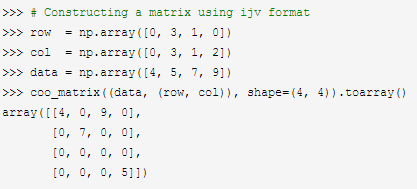graph attention network(ICLR2018)官方代码详解(tensorflow)-稀疏矩阵版
论文地址:https://arxiv.org/abs/1710.10903
代码地址: https://github.com/Diego999/pyGAT
之前非稀疏矩阵版的解读:https://www.cnblogs.com/xiximayou/p/13622283.html
我们知道图的邻接矩阵可能是稀疏的,将整个图加载到内存中是十分耗费资源的,因此对邻接矩阵进行存储和计算是很有必要的。
我们已经讲解了图注意力网络的非稀疏矩阵版本,再来弄清其稀疏矩阵版本就轻松了,接下来我们将来看不同之处。
主运行代码在:execute_cora_sparse.py中
同样的,先加载数据:
adj, features, y_train, y_val, y_test, train_mask, val_mask, test_mask = process.load_data(dataset)
其中adj是coo_matrix类型,features是lil_matrix类型。
对于features,我们最终还是:
def preprocess_features(features):
"""Row-normalize feature matrix and convert to tuple representation"""
rowsum = np.array(features.sum(1))
r_inv = np.power(rowsum, -1).flatten()
r_inv[np.isinf(r_inv)] = 0.
r_mat_inv = sp.diags(r_inv)
features = r_mat_inv.dot(features)
return features.todense(), sparse_to_tuple(features)
将其:
features, spars = process.preprocess_features(features)
转换为原始矩阵。
对于biases:
if sparse:
biases = process.preprocess_adj_bias(adj)
else:
adj = adj.todense()
adj = adj[np.newaxis]
biases = process.adj_to_bias(adj, [nb_nodes], nhood=1)
如果是稀疏格式的,就调用biases = process.preprocess_adj_bias(adj):
def preprocess_adj_bias(adj):
num_nodes = adj.shape[0] #
adj = adj + sp.eye(num_nodes) # self-loop 给对角上+1
adj[adj > 0.0] = 1.0 #大于0的值置为1
if not sp.isspmatrix_coo(adj):
adj = adj.tocoo()
adj = adj.astype(np.float32) #类型转换
indices = np.vstack((adj.col, adj.row)).transpose() # This is where I made a mistake, I used (adj.row, adj.col) instead
# return tf.SparseTensor(indices=indices, values=adj.data, dense_shape=adj.shape)
return indices, adj.data, adj.shape
这里看两个例子:


我们可以通过indices,data,shape来构造一个coo_matrix。
在定义计算图中的占位符时:
if sparse:
#bias_idx = tf.placeholder(tf.int64)
#bias_val = tf.placeholder(tf.float32)
#bias_shape = tf.placeholder(tf.int64)
bias_in = tf.sparse_placeholder(dtype=tf.float32)
else:
bias_in = tf.placeholder(dtype=tf.float32, shape=(batch_size, nb_nodes, nb_nodes))
使用bias_in = tf.sparse_placeholder(dtype=tf.float32)。
再接着就是模型中了,在utils文件夹下的layers.py中:
# Experimental sparse attention head (for running on datasets such as Pubmed)
# N.B. Because of limitations of current TF implementation, will work _only_ if batch_size = 1!
def sp_attn_head(seq, out_sz, adj_mat, activation, nb_nodes, in_drop=0.0, coef_drop=0.0, residual=False):
with tf.name_scope('sp_attn'):
if in_drop != 0.0:
seq = tf.nn.dropout(seq, 1.0 - in_drop) seq_fts = tf.layers.conv1d(seq, out_sz, 1, use_bias=False) # simplest self-attention possible
f_1 = tf.layers.conv1d(seq_fts, 1, 1)
f_2 = tf.layers.conv1d(seq_fts, 1, 1) f_1 = tf.reshape(f_1, (nb_nodes, 1))
f_2 = tf.reshape(f_2, (nb_nodes, 1)) f_1 = adj_mat*f_1
f_2 = adj_mat * tf.transpose(f_2, [1,0]) logits = tf.sparse_add(f_1, f_2)
lrelu = tf.SparseTensor(indices=logits.indices,
values=tf.nn.leaky_relu(logits.values),
dense_shape=logits.dense_shape)
coefs = tf.sparse_softmax(lrelu) if coef_drop != 0.0:
coefs = tf.SparseTensor(indices=coefs.indices,
values=tf.nn.dropout(coefs.values, 1.0 - coef_drop),
dense_shape=coefs.dense_shape)
if in_drop != 0.0:
seq_fts = tf.nn.dropout(seq_fts, 1.0 - in_drop) # As tf.sparse_tensor_dense_matmul expects its arguments to have rank-2,
# here we make an assumption that our input is of batch size 1, and reshape appropriately.
# The method will fail in all other cases!
coefs = tf.sparse_reshape(coefs, [nb_nodes, nb_nodes])
seq_fts = tf.squeeze(seq_fts)
vals = tf.sparse_tensor_dense_matmul(coefs, seq_fts)
vals = tf.expand_dims(vals, axis=0)
vals.set_shape([1, nb_nodes, out_sz])
ret = tf.contrib.layers.bias_add(vals) # residual connection
if residual:
if seq.shape[-1] != ret.shape[-1]:
ret = ret + conv1d(seq, ret.shape[-1], 1) # activation
else:
ret = ret + seq return activation(ret) # activation
相应的位置都要使用稀疏的方式。
graph attention network(ICLR2018)官方代码详解(tensorflow)-稀疏矩阵版的更多相关文章
- graph attention network(ICLR2018)官方代码详解(te4nsorflow)
论文地址:https://arxiv.org/abs/1710.10903 代码地址: https://github.com/Diego999/pyGAT 我并没有完整看过这篇论文,但是在大致了解其原 ...
- 代码详解:TensorFlow Core带你探索深度神经网络“黑匣子”
来源商业新知网,原标题:代码详解:TensorFlow Core带你探索深度神经网络“黑匣子” 想学TensorFlow?先从低阶API开始吧~某种程度而言,它能够帮助我们更好地理解Tensorflo ...
- DeepLearning tutorial(3)MLP多层感知机原理简介+代码详解
本文介绍多层感知机算法,特别是详细解读其代码实现,基于python theano,代码来自:Multilayer Perceptron,如果你想详细了解多层感知机算法,可以参考:UFLDL教程,或者参 ...
- ARM Cortex-M底层技术(2)—启动代码详解
杂谈 工作了一天,脑袋比较乱.一直想把底层的知识写成一个系列,希望可以坚持下去.为什么要写底层的东西呢?首先,工作用到了这部分内容,最近和内部Flash打交道比较多,自然而然会接触到一些底层的东西:第 ...
- 论文解读(FedGAT)《Federated Graph Attention Network for Rumor Detection》
论文信息 论文标题:Federated Graph Attention Network for Rumor Detection论文作者:Huidong Wang, Chuanzheng Bai, Ji ...
- BM算法 Boyer-Moore高质量实现代码详解与算法详解
Boyer-Moore高质量实现代码详解与算法详解 鉴于我见到对算法本身分析非常透彻的文章以及实现的非常精巧的文章,所以就转载了,本文的贡献在于将两者结合起来,方便大家了解代码实现! 算法详解转自:h ...
- ASP.NET MVC 5 学习教程:生成的代码详解
原文 ASP.NET MVC 5 学习教程:生成的代码详解 起飞网 ASP.NET MVC 5 学习教程目录: 添加控制器 添加视图 修改视图和布局页 控制器传递数据给视图 添加模型 创建连接字符串 ...
- Github-karpathy/char-rnn代码详解
Github-karpathy/char-rnn代码详解 zoerywzhou@gmail.com http://www.cnblogs.com/swje/ 作者:Zhouwan 2016-1-10 ...
- 十图详解tensorflow数据读取机制(附代码)转知乎
十图详解tensorflow数据读取机制(附代码) - 何之源的文章 - 知乎 https://zhuanlan.zhihu.com/p/27238630
随机推荐
- java如何实现发送邮箱
package cn.buy.util; import java.security.GeneralSecurityException; import java.util.Properties; imp ...
- CPF 入门教程 - 数据绑定和命令绑定(二)
CPF netcore跨平台UI框架 系列教程 CPF 入门教程(一) CPF 入门教程 - 数据绑定和命令绑定(二) 数据绑定和Wpf类似,支持双向绑定.数据绑定和命令绑定是UI和业务逻辑分离的基础 ...
- 把H2数据库从jar包部署到Kubernetes,并解决Ingress不支持TCP的问题
1 前言 欢迎访问南瓜慢说 www.pkslow.com获取更多精彩文章! H2 Database是一个优秀的数据库,又小又方便,支持内存和文件形式,经常会在测试.POC(proof of conce ...
- 在Linux使用虚拟环境
定义 “虚拟环境”,是python解释器的一个私有副本.在这个环境中,你可以安装私有包,而且不会影响系统中安装的全局python解释器. 作用 为每个程序单独创建虚拟环境时,可以保证程序只能访问虚拟环 ...
- Dotnet Core Public API的安全实践
公开API的安全,其实更重要. 一.API的安全 作为一个Dotnet Core的老司机,写API时,能兼顾到API的安全,这是一种优雅. 通常,我们会用认证来保证API的安全,无敌的Auth ...
- FCIS:Fully Convolutional Instance-aware Semantic Segmentation
论文:Fully Convolutional Instance-aware Semantic Segmentation 目录 0.简介 1.Position-sensitive Score Map ...
- golang time包
1.时间类型 time.Time类型表示时间. func demo() { now := time.Now() //获取当前时间 fmt.Printf("Now:%v\n", no ...
- 计算机网络-网络层(6)ICMP协议
互联网控制报文协议(ICMP,Internet Control Message Protocol),被主机和路由器用来彼此沟通网络层的信息 ICMP报文是承载在IP分组中的,即lCMP报文是作为IP有 ...
- Java面试题 200+
面试题包含的内容了十九了模块:Java 基础.容器.多线程.反射.对象拷贝.Java Web 模块.异常.网络.设计模式.Spring/Spring MVC.Spring Boot/Spring Cl ...
- 安装yarn 心得分享
初次使用yarn ,坑的我,全局安装完@vue/cli,安装之后就是说vue不是内部命令,研究好久,总结一下分享大家一起学习 1,首先安装yarn: 安装yarn 去官网下载yarn 安装包 默认安装 ...
